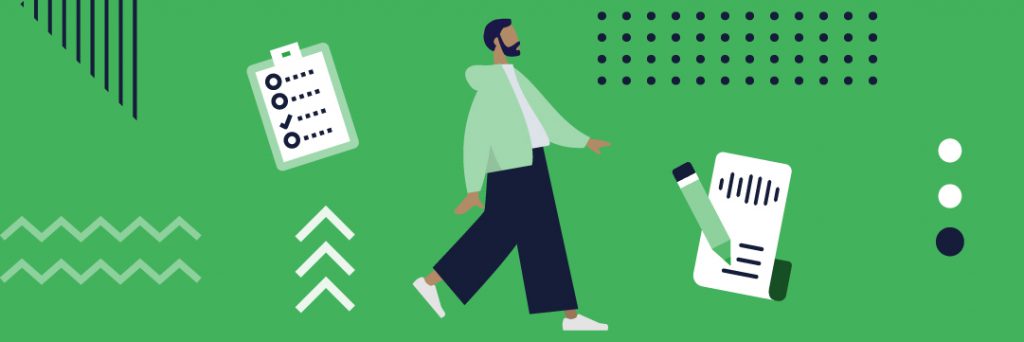Writing a transcript involves writing, typing, or printing information that was originally presented in a different media like audio or video.
Every transcriber needs these three things more than anything else;
- Patience
- Very good listening skills
- Keen editing skills
Transcription can take a lot of time, especially if you are doing it manually. You’ll first have to write the first draft, proof it for errors, and then format it to look professional.
This article will tell you all you need to know about writing a good transcript.
Transcription Methods
First, here are some basic transcription terms you should know:
Full Verbatim
This method of transcription dictates that when writing the transcript, you should include every single word or sound in the recording, be it an ‘aaah’, a pause, a false start, or a stutter.
Why would you want to go with this kind of transcription method?
- For legal purposes where it is important to record what was said, and also how it was said.
- For research purposes
Full verbatim is important because it helps to preserve the context of the original audio file.
Clean Verbatim/ Edited Version
A clean verbatim transcript is a bit more polished than the full verbatim version, making it easier to read. This can sometimes affect the original context of the audio.
The edited version transcription method is used in the following instances:
- For meeting recordings that need to be published.
- To record interviews that are to be used as a basis for articles.
- Recording notes that you want for your own reference.
Detailed Version
This type of transcript is summarized down to the important details of the recording. The reader gets a full picture of the events without having to go through tons of information.
Yes, transcription can be a long and tedious process, but you will be glad you did it.
Here are all the benefits of transcribing your content:
Benefits of Writing a Transcript
Transcription can be a long and tedious process, but you will be glad you did it.
Transcripts are great references.
And even with the rise of video and audio marketing, the written word still holds power because it allows readers to quickly skim through the content.
It’s also possible to search for keywords on transcripts and get the information you want within seconds.
Legal, medical, and academic transcripts are especially important because they are used as references for decades after they are published.
They are sharable
You can upload your transcribed content as a blog post, or even post it on social media. Text files don’t take up a lot of space, and they are easy to share and read: take advantage of this and elevate your brand through transcription.
Transcription can increase your viewership.
Social media marketing is a fast-growing industry, and getting it right is key to winning over millions of followers.
But there are a few factors you should consider:
- 83% of people watch their videos on mute. Maybe they don’t have headphones, or maybe they are just passing through your content waiting for your awesome transcription to catch their attention.
- Audiences who are hard of hearing have a population of about 470 million people.
- Lastly, transcription helps because it allows your audience to refer if they missed something on the audio or misheard a certain word.
Maximize SEO
Search engines might not be able to crawl through video and audio as well as they do through text. Transcribing your content is a sure way to ensure you target all the important keywords. It also makes your content easier to find online.
How to Write a Transcript
It is normal to find transcripts in almost every industry.
Some examples include;
- Legal transcriptions
- Business transcriptions
- Academic transcriptions
- Medical transcriptions
- Interview transcriptions
- Market research transcriptions
…and many more.
Writing transcripts is important because it helps to keep accurate and accessible records of the information that was exchanged within the interview.
You can either write a transcript in real-time or use a recording of a video or audio file.
Your options are;
- To write the transcript yourself
- Hire a professional transcription expert to do it for you at an affordable fee
- Use free or paid transcription software

Ask the Right Questions
What is the purpose of the transcript?
Is it for future reference or you just need a quick reference for your personal use? Do you need it to be a word-for-word account or you just need a general summary of the events that took place?
Who is your audience? The type of transcript that a lawyer would use will be different from the one used by a salesperson.
It’s important to answer these questions and have a general direction of what you want the transcript to look like.
Understand the Limits of the Transcription Process
On your journey as a transcriptionist, you may encounter challenges like:
- Poor audio quality
- Overlapping audio
- Incoherent accents or speech impediments.
Understanding that these challenges exist will allow you to be better prepared (and to get the right tools). For instance, it helps to know which software can clean up your audio.
You cal also seek the help of an audio engineer.
Tool You’ll Need
You can transcribe with a piece of paper and a pen. Having the right tools for the job, however, gives you the advantage of slowing down, cleaning up, rewinding, and fast-forwarding the audio.
Here are some tools that you need for transcription:
- A computer or laptop
- Noise-canceling headphones to help you focus on the audio.
And finally, you’ll need…
The right transcription software
Transcription software will allow you to write your transcript without switching programs. Here are some examples you can try:
Transcribe
This software offers two ways of writing a script. The first is the traditional way which involves typing out the words you hear.
The second involves voice recognition. All you have to do is recite the words you hear and Transcribe will type them on the screen.
Express Scribe
There is a paid version and a free version.
The free version comes with foot pedal support and allows you to choose from a wide range of audio file types. You can also adjust the playback option to suit your typing speed.
Even with the free version, you still get a slot of advanced features in Express Scribe. This software is perfect for professional transcript writers.
Inqscribe
This software provides you with a wide range of keyboard shortcuts that you can customize according to your preference.
The FTW Transcriber
This software can be downloaded and installed on your smartphone or tablet. The FTW Transcriber is only compatible with Windows or Android operating systems.
It has the same features as the Express Scribe with an even greater playback quality. Be sure to check it out.
OTranscribe
You can access OTranscribe through your web browser.
This software allows you to display your text editor and your audio player in the same window, saving you the hustle of moving from tab to tab.
Ultimately, the software you choose to use will depend on your budget and accessibility.
Even while using a program to transcribe your content, remember to include time stamps and speaker identification. A lot of the transcription software in the market have shortcuts for adding timestamps to your transcript.
What are Time Stamps?
Times stamps are used to show the exact time a certain statement was said in a recording. They particularly come in handy when writing transcripts for video because make it easier to synchronize the text with a specific scene in the video.
A time stamp follows this order: [hour:minute:second].
Audio and video editors also use timestamps to mark the parts that need editing.
When Writing the Transcript
Now that you have checked all that, it’s time to get to the actual writing of the transcript.
If you want, you could start writing your transcript as soon as you get the recording or audio.
But…
It’s best to listen to the recording first before doing anything else.
This way, you get to know how many speakers are there and prepare for any other inconveniences in the audio.
Jumping into the process without first listening to the audio might slow you down.
The first transcript you write should be a rough draft.
Don’t worry about spelling, and you can even write in short form as you start. What you want is a rough document that is readable, and after you finish, you can revisit the transcript and revise it accordingly.
Proofreading your Transcript
The third step is where you revise your transcript and correct any spelling mistakes, polish any errors, edit the titles and the paragraphs, and format the transcript to your liking.
Outsourcing your work to a third party comes with some pros and cons.
One benefit is that you will get your transcript back quicker, hence saving you a lot of time. Hiring the wrong professional, however, can give you terrible results. A transcriber who is not familiar with your industry might misspell some technical terms.
To avoid this, you should always hire from trusted outsourcing websites like Bunny Studio.
What Makes Top Quality Outsourcing Websites?
Take Action
Writing a transcript can be a very grueling process, but with a little practice and patience, it is possible to transcribe content like a pro.
There is a lot of helpful information on transcription plus free transcription software at your disposal – don’t be afraid to use it.
It doesn’t matter whether you are transcribing content for a podcast, a YouTube video, or a TV show: your transcript should be professionally done.
If you lack the necessary skills, equipment, or access to good transcription software, don’t hesitate to hire the best transcription experts in the biz!
All the best!










